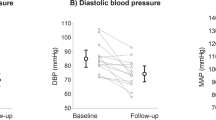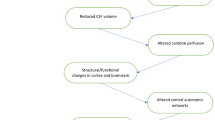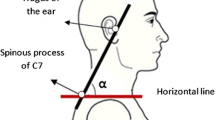Abstract
Gravity associated with postural changes has a strong bearing on haemodynamics of blood flow in arteries. Its effect on stenosed cases has not been widely investigated. In the present study, variation observed in blood flow during postural changes is investigated for different conditions like standing, sleeping and head-down position. A fluid structure interaction study is carried out for idealized normal and 75 % eccentric and concentric stenosed common carotid normal artery. The results clearly indicate the effects of altered gravity on flow conditions. It was found to be very significant during head-down position and demonstrated very high arterial blood pressure in stenosed common carotid when compared with normal carotid.
























Similar content being viewed by others
References
Tang D, Kobayashi S, Zheng J (2003) Effect of stenosis asymmetry on blood flow and artery compression: a three-dimensional fluid structure interaction model. Ann Biomed Eng 31(10):1182–1193
Abdul Khader SM, Shenoy BS, Raghuvir Pai B, Mahmood NS, Kamath G, Rao VRK (2011) Effect of increased severity in patient specific stenosis of common carotid artery using CFD-A case study. World J Model Simul 7(2):113–122
Abdul Khader SM, Ayachit A, Raghuvir Pai B, Rao VRK, Kamath SG (2012) FSI simulation of common carotid under normal and high blood pressures, advances in mechanical engineering 2012
Loring BR (1993) Human cardiovascular control. Oxford University Press
Savin E, Bailliart O, Checoury A, Bonnin P, Grossin C, Martineaud JP (1995) Influence of posture on middle cerebral artery mean flow velocity in humans. Eur J Appl Physiol 71(2–3):161–165
Olufsen MS, Ottesen JT, Tran HT, Ellwein LM (2007) Blood pressure and blood flow variation during postural change from sitting to standing : model development and validation. Appl Physiol 99(4):1523–1537
Janneke G (2005) Postural changes in humans: effects of gravity on the circulation. Ph.D thesis, Cardiovascular Research Institute, Amsterdam
Azhim A, Katai M, Akutagawa M, Hirao Y, Yoshizaki K, Obara S (2006) Measurement of blood flow velocity waveforms in the carotid, brachial and femoral arteries during postural change. Proceeding of international conference on biomedical and pharmaceutical engineering pp 438–442
Peterson K, Ozawa ET, Pantalos GM, Sharp MK (2002) Numerical simulation of the influence of gravity and posture on cardiac performance. Ann Biomed Eng 30(2):247–259
Kim CS, Kiris C, Kwak D, David T (2006) Numerical simulation of local blood flow in the carotid and cerebral arteries under altered gravity. J Biomech Eng 128(2):194–202
Alirezaye-Davatgar M (2006) Numerical simulation of blood flow in the systemic vasculature incorporating gravitational force with application to the cerebral circulation. Ph.D thesis, The University of New South Wales
Ferziger J, Peric M (2002) Computational methods for fluid dynamics, Heidelberg, Berlin
Torii R, Oshima M, Kobayashi T, Takagi K, Tezduyar TE (2006) Computer modeling of cardiovascular fluid–structure interactions with the deforming-spatial-domain/stabilized space–time formulation. Comput Methods Appl Mech Eng 195(13–16):1885–1895
ANSYS Release 13.0 Documentation (2011) ANSYS Company, Pittsburgh
Alberto Figueroa C (2006) A coupled-momentum method to model blood flow and vessel deformation in human arteries: applications in disease research and simulation-based medical planning. Ph.D thesis, Stanford University
Ku DN (1997) Blood flow in arteries. Annu Rev Fluid Mech 29(1):399–434
Tang D, Yang C, Huang Y, Ku DN (1999) Wall stress and strain analysis using a three-dimensional thick-wall model with fluid–structure interactions for blood flow in carotid arteries with stenoses. Comput Struct 72:341–356
Moriyama K, Ifuku H (2007) Assessment of cardiac contractility during a cold pressor test by using (dP/dt)/P of carotid artery pulses. Eur J Appl Physiol 100(2):185–191
Torii R, Oshima M, Kobayashi T, Takagi K, Tezduyar TE (2008) Fluid–structure interaction modeling of a patient-specific cerebral aneurysm: influence of structural modeling. Comput Mech 43(1):151–159
Vignon-Clementel IE (2006) A coupled multidomain method for computational modeling of blood flow. Ph.D thesis, Stanford University
Bhaskaran S (2008) Effects of altered gravity on insects, plants and the human cardiovascular system. Ph.D thesis, University of Pune
Deshpande MD, Giddens DP (1976) Steady laminar flow through modeled vascular stenoses. J Biomech 9:165–173
Long Q, Xu XY, Ramnarine KV, Hoskins P (2001) Numerical investigation of physiologically realistic pulsatile flow through arterial stenosis. J Biomech 34(10):1229–1242
Tezduyar TE, Takizawa K, Moorman C, Christopher J (2009) Multiscale sequentially-coupled arterial FSI technique. Comput Mech 46(1):17–29
Ai L, Zhang L, Dai W, Hu C, Shung KK, Hsiai TK (2010) Real-time assessment of flow reversal in an eccentric arterial stenotic model. J Biomech 43(14):2678–2683
Lee KW, Xu XY (2002) Modelling of flow and wall behaviour in a mildly stenosed tube. Med Eng Phys 24(9):575–586
Fung Y (1984) Biodynamics-circulation. Springer, New York
Rayz VL, Boussel L, Lawton MT, Acevedo-Bolton G, Ge L, Young WL, Higashida RT, Saloner D (2008) Numerical modeling of the flow in intracranial aneurysms: prediction of regions prone to thrombus formation. Ann Biomed Eng 36(11):1793–1804
Varghese SS, Steven HF (2003) Numerical modeling of pulsatile turbulent flow in stenotic vessels. J Biomech Eng 125(4):445–460
Valencia A, Villanueva M (2006) Unsteady flow and mass transfer in models of stenotic arteries considering fluid-structure interaction. Int Commun Heat Mass Transf 33(8):966–975
Tambasco M (2002) Lagrangian hemodynamics of the stenosed carotid bifurcation. Ph.D thesis, The University of Western Ontario
Feng R, Xenos M, Girdhar G, Kang W, Davenport JW, Deng Y, Bluestein D (2012) Viscous flow simulation in a stenosis model using discrete particle dynamics: a comparison between DPD and CFD. Biomech Model Mechanobiol 11(1–2):119–129
Li MX, Beech-Brandt JJ, John LR, Hoskins PR (2007) Numerical analysis of pulsatile blood flow and vessel wall mechanics in different degrees of stenoses. J Biomech 40(16):3715–3724
Salsac AV, Sparks SR, Lasheras JC (2004) Hemodynamic changes occurring during the progressive enlargement of abdominal aortic aneurysm. Ann Vasc Surg 18(1):14–21
Brook BS, Falle SAEG, Pedley TJ (1999) Numerical solutions for unsteady gravity-driven flows in collapsible tubes: evolution and roll-wave instability of a steady state. J Fluid Mech 396:223–256
Jung H, Choi JW, Park CG (2004) Asymmetric flows of non-newtonian fluids in symmetric stenosed artery. Rheology 16(2):101–108
Pontrelli G (2001) Blood flow through an axisymmetric stenosis. Proc Inst Mech Eng [H] 215(1):1–10
Li ZY, Taviani V, Tang T, Sadat U, Young V, Patterson GM, Gillard JH (2009) The mechanical triggers of plaque rupture: shear stress versus pressure gradient. British J Radiol 82:S39–S45
Molla M (2009) LES of pulsatile flow in the models of arterial stenosis and aneurysm. Ph.D thesis, University of Glasgow
Tang D, Yang C, Kobayashi S, Ku DN (2001) Steady flow and wall compression in stenotic arteries: a three-dimensional thick-wall model with fluid–wall interactions. J Biomech Eng 123(6):548–557
Gao H (2010) Carotid plaque stress analysis by fluid structure interaction based in in-vivo mri: implications to plaque vulnerability assessment. Ph.D thesis, Brunel University
Salzar RS, Thubrikar MJ, Eppink RT (1995) Pressure-induced mechanical stress in the carotid artery bifurcation: a possible correlation to atherosclerosis. J Biomech 28(11):1333–1340
Zhao SZ, Xu XY, Hughes AD, Thom SA, Stanton AV (2000) Blood flow and vessel mechanics in a physiologically realistic model of a human carotid arterial bifurcation. J Biomech 33(8):975–984
Perktold K, Rappitsch G (1995) Computer simulation of local blood flow and vessel mechanics in a compliant carotid artery bifurcation model. J Biomech 28(7):845–856
Younis HF, Kaazempur-Mofrad MR, Chan RC, Isasi AG (2004) Hemodynamics and wall mechanics in human carotid bifurcation and its consequences for atherogenesis: investigation of inter-individual variation. Biomech Model Mechanobiol 3(1):17–32
Castellano V, Olive JL, Stoner L, Black C, Mccully KK (2004) Blood flow response to a postural challenge in older men and women. Dyn Med 3:1–8
Lee SE, Lee SW, Fischer PF, Bassiouny HS, Loth F (2008) Direct numerical simulation of transitional flow in a stenosed carotid bifurcation. J Biomech 41(11):2551–2561
Aaslid R, Lindegaard KF, Sorteberg W, Nornes H (1989) Cerebral autoregulation dynamics in humans. Stroke 20:45–52
Greene NH, Lee LA (2012) Advances in anesthesia modern and evolving understanding of cerebral perfusion and autoregulation. Adv Anesthesia 30(1):97–129
Krause N, Lynch JW, Kaplan GA, Cohen RD, Salonen R, Kaplan A, Cohen D, Lynch W (2000) Standing at work and progression of carotid atherosclerosis. Scand J Work Environ Health 26(3):227–236
Author information
Authors and Affiliations
Corresponding author
Rights and permissions
About this article
Cite this article
Raghuvir Pai, B., Ayachit, A., Abdul Khader, S.M. et al. Effect of postural changes on normal and stenosed common carotid artery using FSI. Australas Phys Eng Sci Med 37, 139–152 (2014). https://doi.org/10.1007/s13246-014-0246-0
Received:
Accepted:
Published:
Issue Date:
DOI: https://doi.org/10.1007/s13246-014-0246-0




